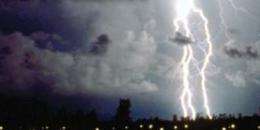Unpredictable Monsoon Season Almost Under Way?

(PhysOrg.com) -- The monsoon is coming. Perhaps this weekend. Maybe. It's always a guessing game when and where and to what extent the annual summer thunderstorms will appear. This year is no different.
Two summers ago, the monsoon season produced a spectacular 9 inches of rain. Last year, it was only a meager 4 inches.
And forecasters, pointing to temperature changes in the Pacific Ocean, suspect it may only produce an average amount of rainfall this summer.
A new website and a new exhibit at the University of Arizona Flandrau Science Center offer plenty of information about monsoon activity in Arizona, said Gary Woodard, the associate director of the UA's Sustainability of semi-Arid Hydrology and Riparian Areas, or SAHRA, now part of Biosphere 2.
Woodard said SAHRA's Monsoon Monitor website is still a work in progress, but it already offers a webcam view of the Tucson Basin from the UA campus, a drought monitor, rainfall data and weather radar. Another window shows a video clip of the previous hour of sky activity in Tucson, which is especially captivating when clouds start to build up.
The monsoon exhibit at Flandrau includes graphics on the structure and mechanics of monsoon storms, lightning, measuring precipitation, rainwater harvesting and thunderstorm photography.
There also is an exhibit of fulgurites, sometimes called petrified or frozen lightning. These are tubular structures created when lightning strikes silica-based soil and heats it to about 3,300 degrees Fahrenheit. The tubes it creates are formed in less than a second.
Woodard also said monsoons are the active focus of a number of UA faculty members at SAHRA and elsewhere on campus. Projects range from basic research on storm modeling, forecasting and tracking sources of monsoon moisture to lightning detection, the quality of storm water runoff and flash flooding in urban areas.
Christopher Castro, an assistant professor of atmospheric sciences at the UA, is researching the role of surface water temperatures in the Pacific in predicting both summer and winter rainfall patterns in Arizona. Castro said predicting current monsoon activity remains elusive but scientific modeling that integrates regional climate data for seasonal forecasts integrated with hydrologic models is one active area of research.
One important factor in improving forecasts is establishing relationships with scientists in Mexico.
"There is a big hole in data gathering in Mexico. If you miss the location of a significant upper-level circulation feature or a surge of moisture from the Gulf of California, that has a really big impact," he said.
There are other reasons to study monsoons. Peter Troch, a professor in hydrology and water resources, said water and fire managers depend on reliable data to avoid shortages and schedule crews to fight wildfires.
Troch pointed to data that show a projected decline of 10 percent to 30 percent in runoff in the seven-state Colorado River Basin over the next 50 years. At the same time, the U.S. Census Bureau projects that population growth in the lower parts of the already parched basin will increase by more than 20 million over the next two decades.
Fires also are a monsoon-related threat this time of year. Winter rains fueled heavy vegetation growth, especially at lower elevations, Troth said.
There already have been a number of fires across Arizona, including three in the Flagstaff area. Some were caused by campfires and other human activity, but others were started by another phenomenon common to monsoons, lightning.
Woodard said technology developed at the UA is improving the ability of forecasters to predict in real time when and where lightning will be a threat. A spinoff company was created by UA researchers and later bought by a company that manufactures detection equipment for meteorologists.
He also acknowledged that Arizona is not the lightning capital of the U.S. That would be Florida.
"But we have quality lightning," Woodard said. "It's no surprise that scientists come from all over the world to study lightning here."
He said that's because clouds here rise thousands of feet in the air and create the ice at their tops believed to be necessary for electrical discharges in the atmosphere. Plus the clear air and mountain backdrops make lightning strikes visible for miles.
Said Woodard: "That makes us the lightning photography capital of the world."
Provided by University of Arizona

















